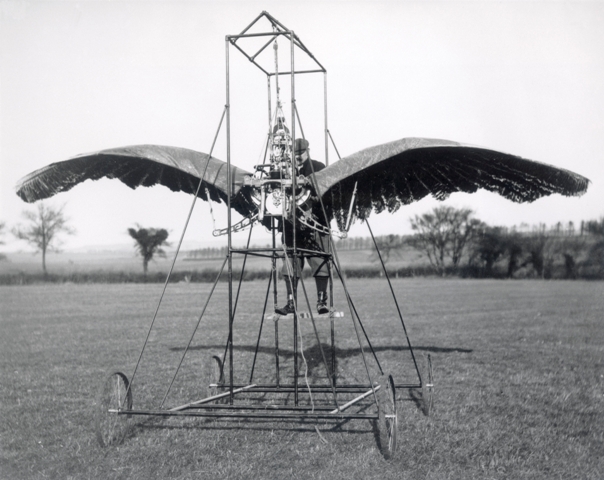Becky Honeycombe from our Learning Support Team writes about one of her favourite objects in the Museum.
Have you ever dreamed of being able to fly like a bird? Well if you have, you’re certainly not alone. The ability to fly has been a human obsession for thousands of years. One of the earliest references to bird-like flight is found in the Ancient Greek myth of Daedalus and Icarus who attached feathers to their arms to escape captivity. However, the story ends in tragedy for Icarus as after a brief flight he crashes to the ground. Sadly, this has been the fate for many humans who have tried to imitate the story and reach the skies, either by attaching wings to their bodies or by making flying machines that mimic a bird’s flight.

Credit: Science Museum/SSPL
These machines are known as ornithopters and they come in a wide variety of shapes and sizes. Some of the earliest designs were drawn by Leonardo da Vinci in the 15th Century, but perhaps one of the strangest can be seen in our Flight gallery. The Frost ornithopter, created in 1904 by Edward Purkis Frost, was designed to replicate the wings of a crow. He used both real and imitated feathers combined with an internal combustion engine in an attempt to get his machine off the ground. Frost avidly studied flight and designed a number of contraptions between 1868 and his death in 1922. Despite his best flight being only a ‘jump’ off the ground and his witnessing the development of the conventional aeroplane, Frost remained convinced he had pursued a worthy cause. When asked about his studies towards the end of his life he stated ‘I do not begrudge the time and trouble I expended upon the attempt. The investigations opened my eyes to the wonders of nature. It is a beautiful study’.

Incredibly, despite the prominence and success of conventional fixed wing aircraft, contemporary scientists continue to be as fascinated as Frost with constructing the perfect ornithopter. In 2010 the University of Toronto successfully achieved the first level sustained flight by a human-powered ornithopter flying 475 ft over 19.3 seconds.
However, despite this success it may not be propelling man into the sky which eventually proves to be the best use for the ornithopter. Recent research has tended to focus on other uses of the technology such as conservation and surveillance. Researchers at the University of Illinois recently developed an ornithopter perfect for urban surveillance. Its ability to mimic the way a bird hovers and lands in confined spaces could make it ideally suited to cramped city conditions.
The history of ornithopters is long and varied, and research into their development and uses looks set to continue for a long time to come.
What other benefits might there be to using ornithopters?
One comment on “Wonderful Things: Frost Ornithopter”
Comments are closed.
They probably won’t be very good for keeping eggs warm, but I think they could provide an excellent service when it comes to delivering emergency supplies and meals to people travelling across rural terrains – or scientists out in the field.